Effect of Innovative Sediment-Based Growing Media on Fruit Quality of Wild Strawberry (Fragaria vesca L.)
Abstract
1. Introduction
2. Materials and Methods
2.1. Growing Media Components, Plant Material and Cultivation
2.2. Leaf Sampling and Pigment Analysis
2.3. Fruit Sampling and Quality Assessment
2.3.1. Nutritional and Nutraceutical Analysis
Determination of Sugars
Total Soluble Solids (TSS)
Determination of Organic Acids
Determination of Organic Phenolics
Determination of 2,2-Diphenyl-1-Picrylhydrazyl (DPPH) Radical-Scavenging Activity
2.3.2. Elemental and Organic Contaminant Analyses
2.3.3. Sensory Evaluation
2.4. Data Analysis
3. Results
3.1. Leaf Pigment Analysis
3.2. Nutritional and Nutraceutical Analysis
3.3. Elemental and Organic Contaminant Analyses
3.4. Sensory Evaluation and Acceptance
3.5. Multi-Trait Approach
3.6. Correlation among Leaf Pigment, Fruit Quality and Substrate Parameters
4. Discussion
4.1. Leaf Pigment Analysis
4.2. Nutritional and Nutraceutical Analysis
4.3. Elemental and Organic Contaminant Analyses
4.4. Sensory Evaluation and Acceptance
4.5. Correlation among Leaf Pigment, Fruit Quality and Substrate Parameters
5. Conclusions
Supplementary Materials
Author Contributions
Funding
Institutional Review Board Statement
Informed Consent Statement
Data Availability Statement
Conflicts of Interest
References
- Bert, V.; Seuntjens, P.; Dejonghe, W.; Lacherez, S.; Thuy, H.T.T.; Vandecasteele, B. Phytoremediation as a Management Option for Contaminated Sediments in Tidal Marshes, Flood Control Areas and Dredged Sediment Landfill Sites. Environ. Sci. Pollut. Res. 2009, 16, 745–764. [Google Scholar] [CrossRef] [PubMed]
- Zhang, H.; Walker, T.R.; Davis, E.; Ma, G. Ecological Risk Assessment of Metals in Small Craft Harbour Sediments in Nova Scotia, Canada. Mar. Pollut. Bull. 2019, 146, 466–475. [Google Scholar] [CrossRef] [PubMed]
- Ferrans, L.; Jani, Y.; Burlakovs, J.; Klavins, M.; Hogland, W. Chemical Speciation of Metals from Marine Sediments: Assessment of Potential Pollution Risk While Dredging, a Case Study in Southern Sweden. Chemosphere 2021, 263, 128105. [Google Scholar] [CrossRef]
- Bartoli, G.; Papa, S.; Sagnella, E.; Fioretto, A. Heavy Metal Content in Sediments along the Calore River: Relationships with Physical–Chemical Characteristics. J. Environ. Manag. 2012, 95, S9–S14. [Google Scholar] [CrossRef]
- Buceta, J.L.; Lloret, A.; Antequera, M.; Obispo, R.; Sierra, J.; Martínez-Gil, M. Nuevo Marco Para La Caracterización y Clasificación Del Material Dragado En España. Ribagua 2015, 2, 105–115. [Google Scholar] [CrossRef]
- Bos, M.G.; Diemont, W.H.; Verhagen, A. Sustainable Peat Supply Chain: Report of the Ad Hoc Working Group Enhancing the Sustainability of the Peat Supply Chain for the Dutch Horticulture; Report UR 2167; Alterra: Wageningen, The Netherlands, 2011. [Google Scholar]
- Ugolini, F.; Calzolari, C.; Lanini, G.M.; Massetti, L.; Pollaki, S.; Raschi, A.; Sabatini, F.; Tagliaferri, G.; Ungaro, F.; Massa, D. Testing Decontaminated Sediments as a Substrate for Ornamentals in Field Nursery Plantations. J. Environ. Manag. 2017, 197, 681–693. [Google Scholar] [CrossRef]
- Tozzi, F.; Renella, G.; Macci, C.; Masciandaro, G.; Gonnelli, C.; Colzi, I.; Giagnoni, L.; Pecchioli, S.; Nin, S.; Giordani, E. Agronomic Performance and Food Safety of Strawberry Cultivated on a Remediated Sediment. Sci. Total Environ. 2021, 796, 148803. [Google Scholar] [CrossRef]
- Tozzi, F.; Pecchioli, S.; Renella, G.; Melgarejo, P.; Legua, P.; Macci, C.; Doni, S.; Masciandaro, G.; Giordani, E.; Lenzi, A. Remediated Marine Sediment as Growing Medium for Lettuce Production: Assessment of Agronomic Performance and Food Safety in a Pilot Experiment. J. Sci. Food Agric. 2019, 99, 5624–5630. [Google Scholar] [CrossRef]
- Martínez-Nicolás, J.J.; Legua, P.; Hernández, F.; Martínez-Font, R.; Giordani, E.; Melgarejo, P. Effect of Phytoremediated Port Sediment as an Agricultural Medium for Pomegranate Cultivation: Mobility of Contaminants in the Plant. Sustainability 2021, 13, 9661. [Google Scholar] [CrossRef]
- Del Bubba, M.; Giordani, E.; Ancillotti, C.; Petrucci, W.A.; Ciofi, L.; Morelli, D.; Marinelli, C.; Checchini, L.; Furlanetto, S.; Del Bubba, M. Morphological, Nutraceutical and Sensorial Properties of Cultivated Fragaria vesca L. Berries: Influence of Genotype, Plant Age, Fertilization Treatment on the Overall Fruit Quality. Agric. Food Sci. 2016, 25, 187–201. [Google Scholar] [CrossRef]
- Nin, S.; Petrucci, W.A.; Del Bubba, M.I.; Giordani, E. Innovative Technologies for Improved Wild Strawberry Production in Marginal Tuscan Areas. Atti Della Soc. Toscana Sci. Nat. Mem. Ser. B 2018, 125, 7–12. [Google Scholar] [CrossRef]
- Doumett, S.; Fibbi, D.; Cincinelli, A.; Giordani, E.; Nin, S.; Del Bubba, M. Comparison of Nutritional and Nutraceutical Properties in Cultivated Fruits of Fragaria vesca L. Produced in Italy. Food Res. Int. 2011, 44, 1209–1216. [Google Scholar] [CrossRef]
- Chambers, A.; Moon, P.; Fu, Y.; Choiseul, J.; Bai, J.; Plotto, A.; Baldwin, E. Yield and Fruit Quality of Sixteen Fragaria vesca Accessions Grown in Southern Florida. Hortscience 2018, 53, 1396–1403. [Google Scholar] [CrossRef]
- Lema-Rumińska, J.; Kulus, D.; Tymoszuk, A.; Miler, N.; Woźny, A.; Wenda-Piesik, A. Physiological, Biochemical, and Biometrical Response of Cultivated Strawberry and Wild Strawberry in Greenhouse Gutter Cultivation in the Autumn-Winter Season in Poland—Preliminary Study. Agronomy 2021, 11, 1633. [Google Scholar] [CrossRef]
- Chini, G.; Bonetti, D.; Tozzi, F.; Antonetti, M.; Pecchioli, S.; Burchi, G.; Masciandaro, G.; Nin, S. Wild Strawberry Production on Innovative Sediment-Based Growing Media: A Reality Challenging the Traditional Concept of “Soilless” Cultivation. Acta Hort. 2023, in press. [Google Scholar]
- Macci, C.; Peruzzi, E.; Doni, S.; Vannucchi, F.; Masciandaro, G. Landfarming as a Sustainable Management Strategy for Fresh and Phytoremediated Sediment. Environ. Sci. Pollut. Res. 2021, 28, 39692–39707. [Google Scholar] [CrossRef]
- Lichtenthaler, H.K.; Buschmann, C. Chlorophylls and Carotenoids: Measurement and Characterization by UV-VIS Spectroscopy. Curr. Protoc. Food Anal. Chem. 2001, 1, F4-3. [Google Scholar] [CrossRef]
- Cataldi, T.R.I.; Campa, C.; De Benedetto, G.E. Carbohydrate Analysis by High-Performance Anion-Exchange Chromatography with Pulsed Amperometric Detection: The Potential Is Still Growing. Fresenius J. Anal. Chem. 2000, 368, 739–758. [Google Scholar] [CrossRef]
- Maurício Duarte-Almeida, J.; Novoa, A.V.; Linares, A.F.; Lajolo, F.M.; Inés Genovese, M. Antioxidant Activity of Phenolics Compounds from Sugar Cane (Saccharum officinarum L.) Juice. Plant Foods Hum. Nutr. 2006, 61, 187–192. [Google Scholar] [CrossRef]
- Chang, C.-H.; Lin, H.-Y.; Chang, C.-Y.; Liu, Y.-C. Comparisons on the Antioxidant Properties of Fresh, Freeze-Dried and Hot-Air-Dried Tomatoes. J. Food Eng. 2006, 77, 478–485. [Google Scholar] [CrossRef]
- UNI EN 13804. Foodstuffs—Determination of Elements and Their Chemical Species—General Considerations and Specific Requirements. 2013. Available online: https://store.uni.com/en/uni-en-13804-2013 (accessed on 15 March 2023).
- UNI EN 13805. Foodstuffs—Determination of Trace Elements—Pressure Digestion. 2014. Available online: https://store.uni.com/en/uni-en-13805-2014 (accessed on 15 March 2023).
- UNI EN ISO 17294-2. UNI EN ISO 17294-2 Water Quality—Application of Inductively Coupled Plasma Mass Spectrometry (ICP-MS)—Part 2: Determination of Selected Elements Including Uranium Isotopes 2016. Available online: https://store.uni.com/en/en-iso-17294-2-2016 (accessed on 15 March 2023).
- UNI CEN/TS 15407 Solid Recovered Fuels-Method for the Determination of Carbon (C), Hydrogen (H) and Nitrogen (N) Content 2006. Available online: https://store.uni.com/cen-ts-15407-2006 (accessed on 15 March 2023).
- UNI EN 14039 Waste Characterization-Determination of Hydrocarbon Content in the Range C10 to C40 by Gas Chromatography 2005. Available online: https://store.uni.com/uni-en-14039-2005 (accessed on 15 March 2023).
- PPA 338 Rev 1. 2021. Available online: htpps://urly.it/3rh23 (accessed on 15 March 2023).
- Wei, T.; Simko, V.R. Package “Corrplot”: Visualization of a Correlation Matrix (Version 0.92). 2021. Available online: https://github.com/taiyun/corrplot (accessed on 22 May 2022).
- Lê, S.; Josse, J.; Husson, F. FactoMineR: An R Package for Multivariate Analysis. J. Stat. Softw. 2008, 25, 1–18. [Google Scholar] [CrossRef]
- Kassambara, A.; Mundt, F. Package ‘Factoextra’: Extract and Visualize the Results of Multivariate Data Analyses. RCRAN 2017, 76, 1–74. [Google Scholar]
- Kolde, R. Pheatmap: Pretty Heatmaps. 2019. Available online: https://CRAN.R-project.org/package=pheatmap (accessed on 12 September 2022).
- Caruso, G.; Villari, A.; Villari, G. Quality Characteristics of Fragaria vesca L. Fruits Influenced by NFT Solution EC and Shading. In Proceedings of the South Pacific Soilless Culture Conference-SPSCC, Palmerston North, New Zealand, 10–13 February 2003; Volume 648, pp. 167–175. [Google Scholar]
- Caruso, G.; Villari, G.; Melchionna, G.; Conti, S. Effects of Cultural Cycles and Nutrient Solutions on Plant Growth, Yield and Fruit Quality of Alpine Strawberry (Fragaria vesca L.) Grown in Hydroponics. Sci. Hortic. 2011, 129, 479–485. [Google Scholar] [CrossRef]
- Zahid, N.; Maqbool, M.; Tahir, M.M.; Horvitz, S.; Hamid, A.; Khalid, M.S.; Ejaz, S.; Jawad, R.; Awan, S.I.; Rehman, A. Influence of Organic and Inorganic Fertilizer Regimes on Growth Patterns and Antioxidants Capacity of Strawberry (Fragaria × ananassa Duch.) Cv. Chandler. J. Food Qual. 2022, 2022, 8618854. [Google Scholar] [CrossRef]
- Jurgiel-Małecka, G.; Gibczyńska, M.; Siwek, H.; Buchwał, A. Comparison of Fruits Chemical Composition of Selected Cultivars Wild Strawberry (Fragaria vesca L.). Eur. J. Hortic. Sci. 2017, 82, 204–210. [Google Scholar] [CrossRef]
- Aslantas, R.; Pirlak, L.; Güleryüz, M. The Nutritional Value of Wild Fruits from the North Eastern Anatolia Region of Turkey. Asian J. Chem. 2007, 19, 3072. [Google Scholar]
- Lin, Z.H.; Chen, C.S.; Zhao, S.Q.; Liu, Y.; Zhong, Q.S.; Ruan, Q.C.; Chen, Z.H.; You, X.M.; Shan, R.Y.; Li, X.L.; et al. Molecular and Physiological Mechanisms of Tea (Camellia sinensis (L.) O. Kuntze) Leaf and Root in Response to Nitrogen Deficiency. BMC Genom. 2023, 24, 27. [Google Scholar] [CrossRef] [PubMed]
- Sarker, U.; Oba, S. Drought Stress Effects on Growth, ROS Markers, Compatible Solutes, Phenolics, Flavonoids, and Antioxidant Activity in Amaranthus tricolor. Appl. Biochem. Biotechnol. 2018, 186, 999–1016. [Google Scholar] [CrossRef] [PubMed]
- Khosropour, E.; Weisany, W.; Tahir-razzak, N.A.; Hakimi, L. Vermicompost and Biochar Can Alleviate Cadmium Stress through Minimizing Its Uptake and Optimizing Biochemical Properties in Berberis integerrima Bunge. Environ. Sci. Pollut. Res. 2022, 29, 17476–17486. [Google Scholar] [CrossRef] [PubMed]
- Wang, Y.; Wang, Y.-M.; Lu, Y.-T.; Qiu, Q.-L.; Fan, D.-M.; Wang, X.-C.; Zheng, X.-Q. Influence of Different Nitrogen Sources on Carbon and Nitrogen Metabolism and Gene Expression in Tea Plants (Camellia sinensis L.). Plant Physiol. Biochem. 2021, 167, 561–566. [Google Scholar] [CrossRef] [PubMed]
- Salman, M.; Ullah, S.; Razzaq, K.; Rajwana, I.A.; Akhtar, G.; Faried, H.N.; Hussain, A.; Amin, M.; Khalid, S. Combined Foliar Application of Calcium, Zinc, Boron and Time Influence Leaf Nutrient Status, Vegetative Growth, Fruit Yield, Fruit Biochemical and Anti-Oxidative Attributes of “Chandler” Strawberry. J. Plant Nutr. 2022, 45, 1837–1848. [Google Scholar] [CrossRef]
- Nin, S.; Bonetti, D.; Antonetti, M.; Peruzzi, E.; Manzi, D.; Macci, C. Sediment-Based Growing Media Provides a Window Opportunity for Environmentally Friendly Production of Ornamental Shrubs. Agronomy 2022, 13, 92. [Google Scholar] [CrossRef]
- Mohamed, M.H.M.; Sami, R.; Al-Mushhin, A.A.M.; Ali, M.M.E.; El-Desouky, H.S.; Ismail, K.A.; Khalil, R.; Zewail, R.M.Y. Impacts of Effective Microorganisms, Compost Tea, Fulvic Acid, Yeast Extract, and Foliar Spray with Seaweed Extract on Sweet Pepper Plants under Greenhouse Conditions. Plants 2021, 10, 1927. [Google Scholar] [CrossRef] [PubMed]
- Havaux, M. Carotenoid Oxidation Products as Stress Signals in Plants. Plant J. 2014, 79, 597–606. [Google Scholar] [CrossRef]
- Ullah, A.; Ali, I.; Noor, J.; Zeng, F.; Bawazeer, S.; Eldin, S.M.; Asghar, M.A.; Javed, H.H.; Saleem, K.; Ullah, S. Exogenous γ-Aminobutyric Acid (GABA) Mitigated Salinity-Induced Impairments in Mungbean Plants by Regulating Their Nitrogen Metabolism and Antioxidant Potential. Front. Plant Sci. 2022, 13, 1081188. [Google Scholar] [CrossRef]
- Sarooshi, R.A.; Cresswell, G.C. Effects of Hydroponic Solution Composition, Electrical Conductivity and Plant Spacing on Yield and Quality of Strawberries. Aust. J. Exp. Agric. 1994, 34, 529–535. [Google Scholar] [CrossRef]
- Ojeda-Real, L.A.; Lobit, P.; Cárdenas-Navarro, R.; Grageda-Cabrera, O.; Farías-Rodríguez, R.; Valencia-Cantero, E.; Macías-Rodríguez, L. Effect of Nitrogen Fertilization on Quality Markers of Strawberry (Fragaria× ananassa Duch. Cv. Aromas). J. Sci. Food Agric. 2009, 89, 935–939. [Google Scholar] [CrossRef]
- Daneshmand, B.; Eshghi, S.; Gharaghani, A.; Eshghi, H. Growth, Mineral Nutrient Composition, and Enzyme Activity of Strawberry as Influenced by Adding Urea and Nickel to the Nutrient Solution. J. Berry Res. 2019, 9, 27–37. [Google Scholar] [CrossRef]
- Preciado-Rangel, P.; Troyo-Diéguez, E.; Valdez-Aguilar, L.A.; García-Hernández, J.L.; Luna-Ortega, J.G. Interactive Effects of the Potassium and Nitrogen Relationship on Yield and Quality of Strawberry Grown under Soilless Conditions. Plants 2020, 9, 441. [Google Scholar] [CrossRef]
- Sidhu, R.S.; Singh, N.P.; Singh, S.; Sharda, R. Foliar Nutrition with Calcium Nitrate in Strawberries (Fragaria× ananassa Duch.): Effect on Fruit Quality and Yield. Indian J. Ecol. 2020, 47, 87–91. [Google Scholar]
- Fageria, N.K. The Use of Nutrients in Crop Plants; CRC Press: Boca Raton, FL, USA, 2016; ISBN 0429150776. [Google Scholar]
- Montero, T.M.; Mollá, E.M.; Esteban, R.M.; López-Andréu, F.J. Quality Attributes of Strawberry during Ripening. Sci. Hortic. 1996, 65, 239–250. [Google Scholar] [CrossRef]
- Wang, S.Y.; Zheng, W.; Galletta, G.J. Cultural System Affects Fruit Quality and Antioxidant Capacity in Strawberries. J. Agric. Food Chem. 2002, 50, 6534–6542. [Google Scholar] [CrossRef] [PubMed]
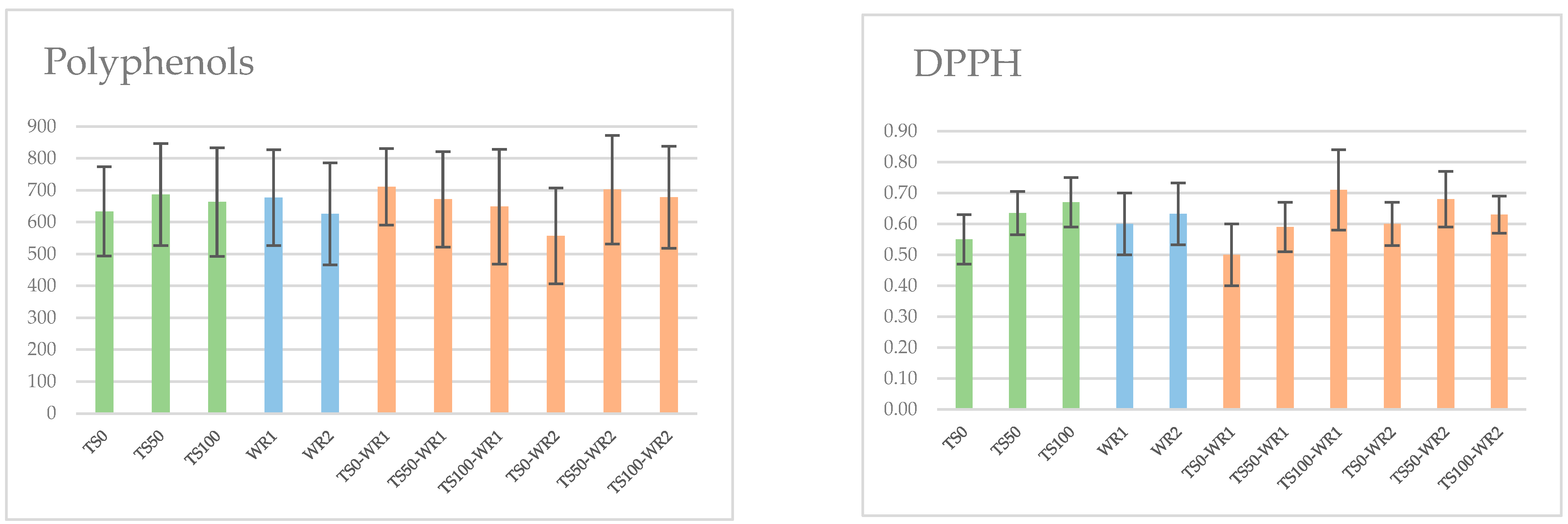
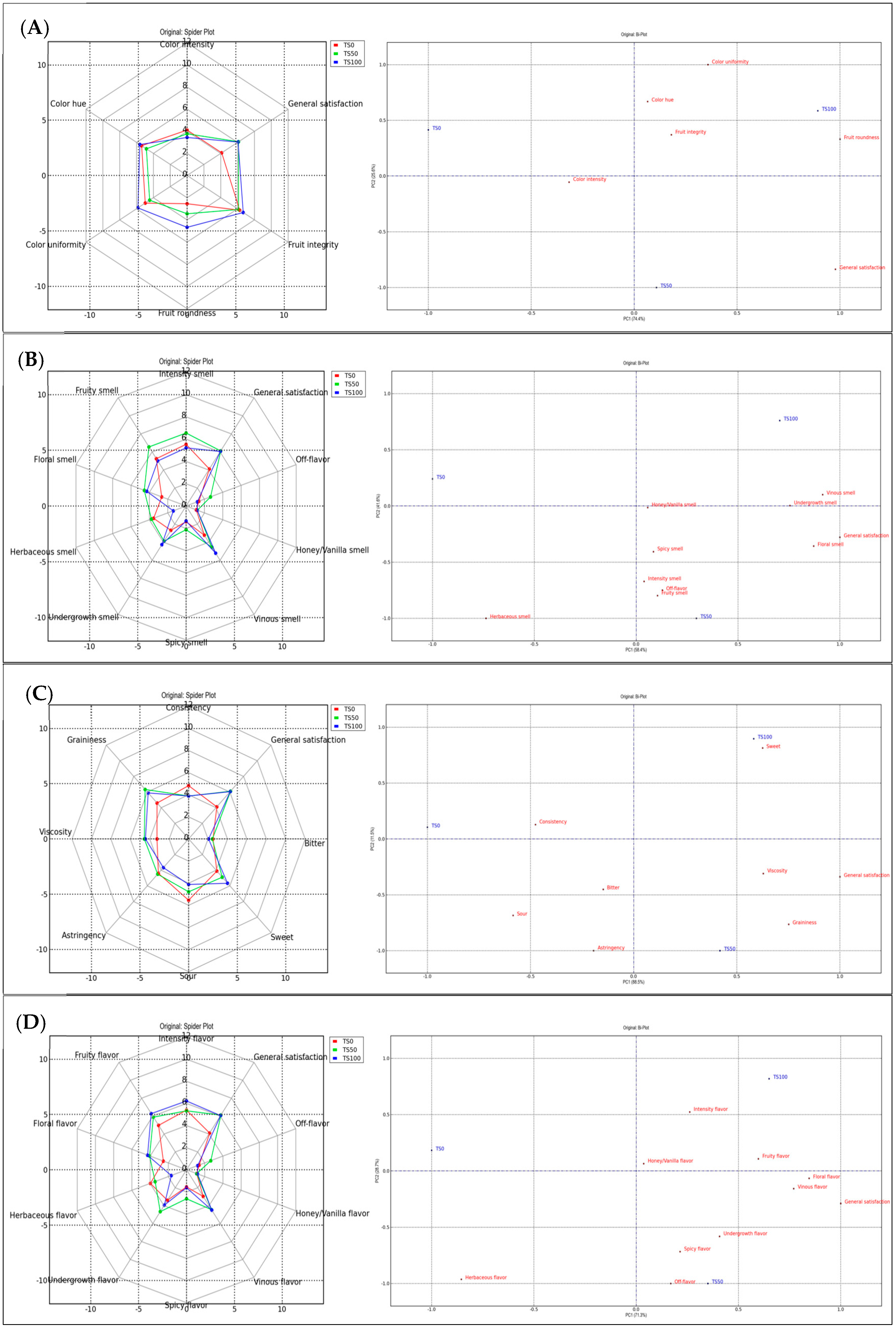
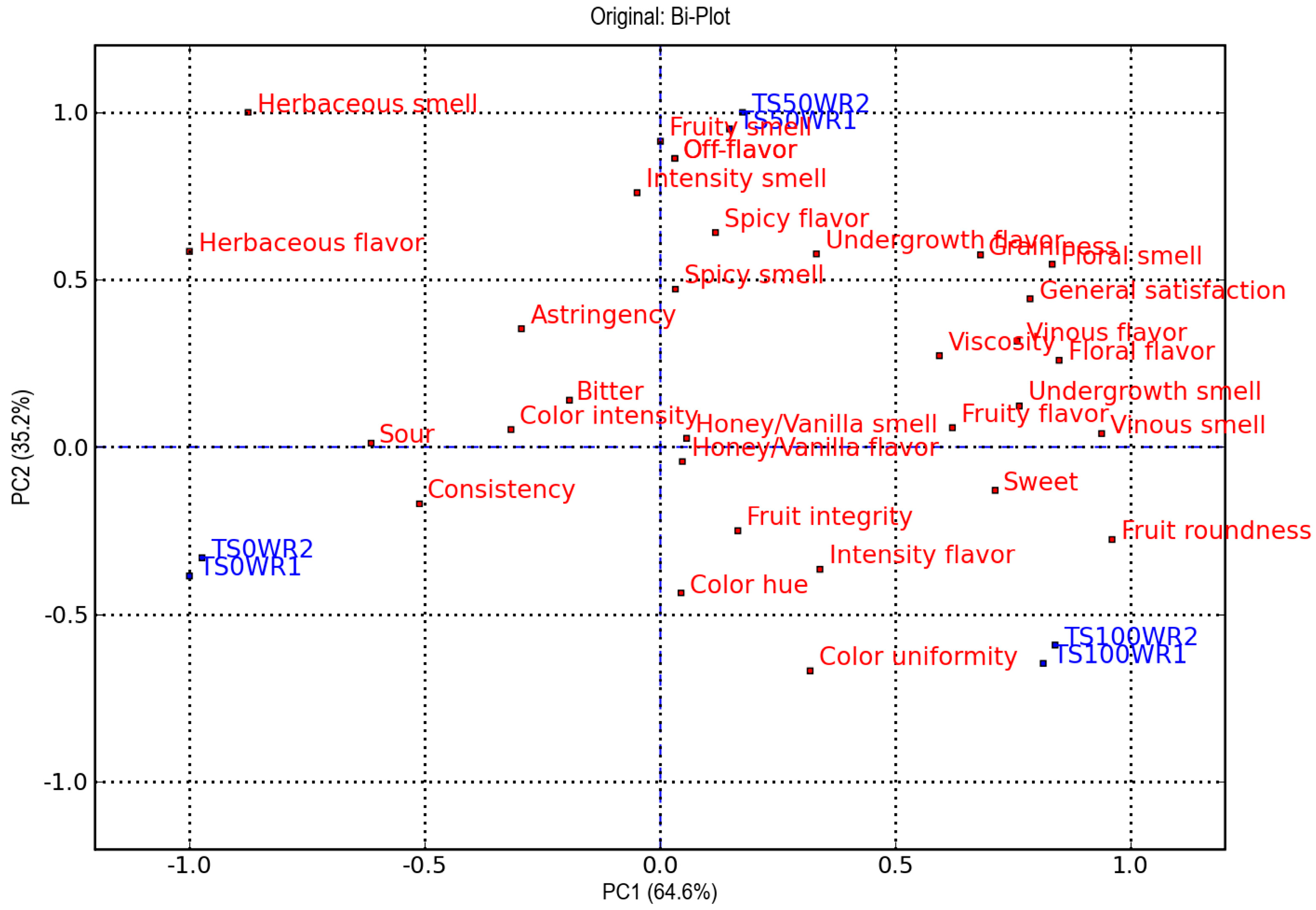
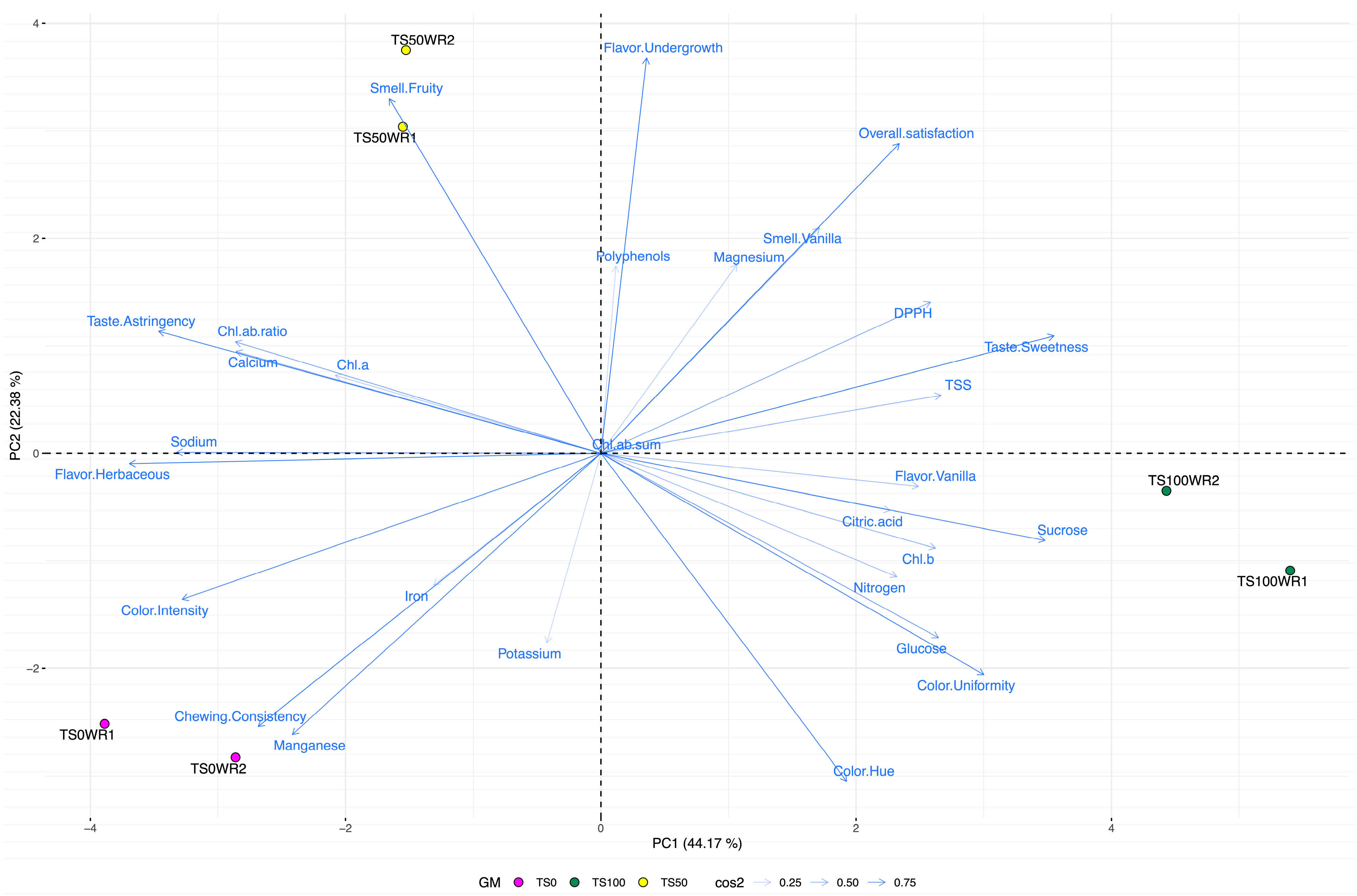
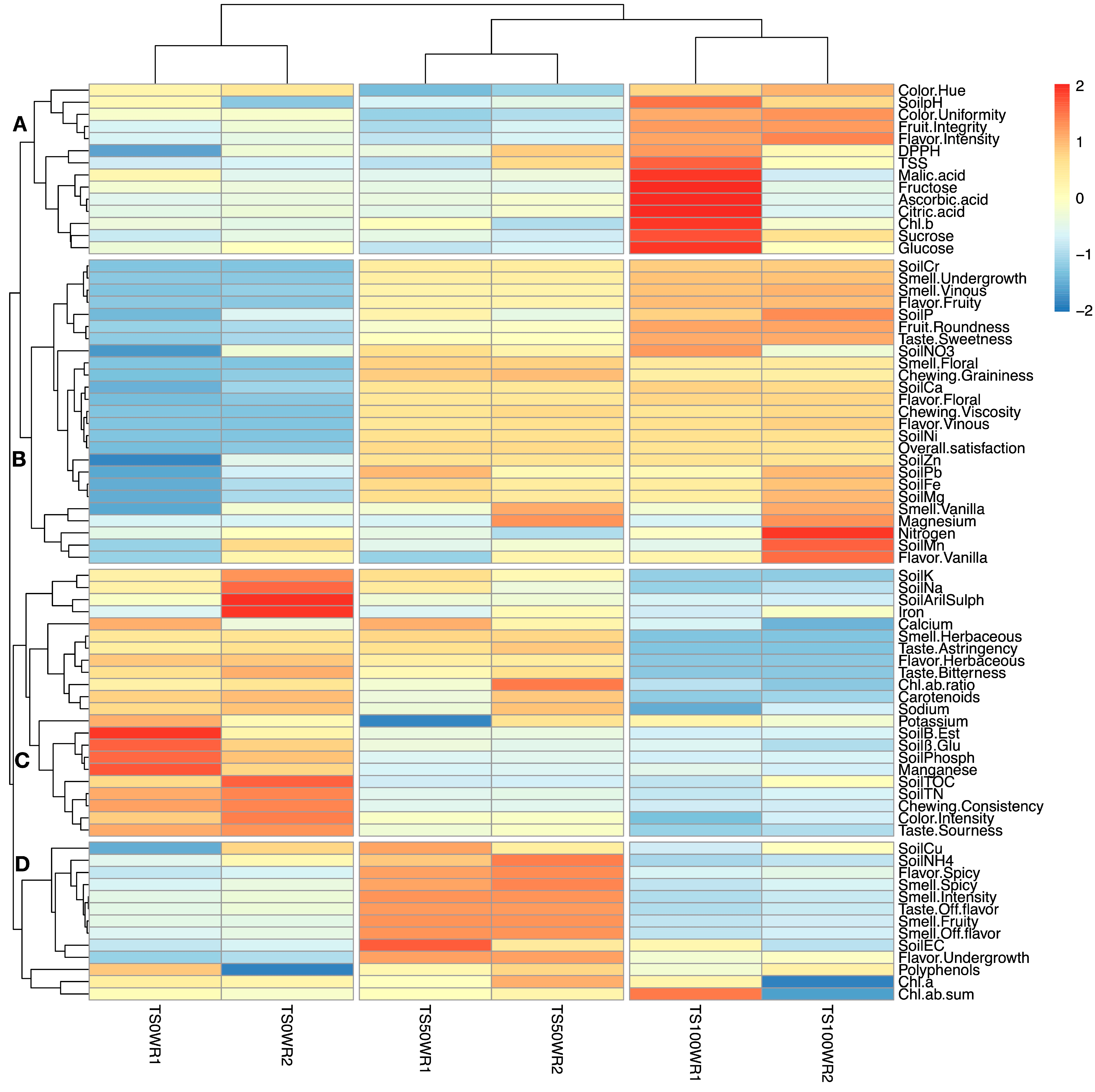
| Parameters | TS0 | TS50 | TS100 |
|---|---|---|---|
| Texture | n.a. | n.a. | Sandy/Loam |
| Bulk density (g cm3) | 0.19 | 1.01 | 1.52 |
| Porosity (%) | 95 | 89 | 76 |
| Water capacity (%) | 81 | 76 | 64 |
| Air capacity (%) | 14 | 13 | 11 |
| Easily available water (%) | 42 | 29 | 20 |
| pH | 5.6 | 7.8 | 8.6 |
| EC (dS m−1) | 0.68 | 0.52 | 0.28 |
| TN (%) | 0.63 | 0.15 | 0.09 |
| TOC (%) | 7.96 | 3.52 | 1.34 |
| TP (g Kg−1) | 0.30 | 0.40 | 0.38 |
| NO3− (mg Kg−1) | 42.9 | 28.5 | 45.7 |
| NH4+ (mg Kg−1) | 11.40 | 6.73 | 0.61 |
| Minerals (g Kg−1) | |||
| Pb | 0.02 | 0.04 | 0.05 |
| Fe | 5.00 | 15.07 | 17.41 |
| Cr | 0.01 | 0.04 | 0.05 |
| Cu | 0.01 | 0.04 | 0.05 |
| Zn | 0.02 | 0.16 | 0.17 |
| Ni | 0.01 | 0.04 | 0.04 |
| Mn | 0.18 | 0.28 | 0.28 |
| Mg | 1.99 | 5.14 | 5.76 |
| Cd | - | - | - |
| K | 5.69 | 3.04 | 1.95 |
| Ca | 4.82 | 25.73 | 24.04 |
| Na | 1.32 | 1.48 | 1.35 |
| Enzimatic activity (µmol/g−1 h−1) | |||
| ß-Glucosidase | 132 | 91 | 90 |
| Phophatase | 1446 | 476 | 147 |
| Aryl Sulfatase | 0 | 40 | 70 |
| Butyrate esterase | 114 | 412 | 574 |
| Factor | Carotenoids (µg/mg FW) | Chl a (µg/mg FW) | Chl b (µg/mg FW) | Chl a + Chl b (µg/mg FW) | Chl a/Chl b (µg/mg FW) |
|---|---|---|---|---|---|
| GM | |||||
| TS0 | 28.80 ± 3.1 a | 1.23 ± 0.19 ns | 0.58 ± 0.12 ns | 1.80 ± 0.26 ns | 2.20 ± 0.45 ns |
| TS50 | 23.98 ± 2.7 a | 1.25 ± 0.11 ns | 0.57 ± 0.11 ns | 1.82 ± 0.16 ns | 2.27 ± 0.45 ns |
| TS100 | 12.20 ± 2.8 b | 1.09 ± 0.20 ns | 0.71 ± 0.15 ns | 1.80 ± 0.27 ns | 1.68 ± 0.34 ns |
| WR | |||||
| WR1 | 19.60 ± 8.19 ns | 1.21 ± 0.10 ns | 0.67 ± 0.13 ns | 1.89 ± 0.20 ns | 1.96 ± 0.39 ns |
| WR2 | 23.72 ± 9.50 ns | 1.17 ± 0.22 ns | 0.56 ± 0.09 ns | 1.73 ± 0.23 ns | 2.14 ± 0.43 ns |
| GM × WR | |||||
| TS0-WR1 | 28.11 ± 2.9 a | 1.24 ± 0.14 ns | 0.58 ± 0.13 ns | 1.82 ± 0.21 ns | 2.16 ± 0.36 ns |
| TS0-WR2 | 29.49 ± 3.3 a | 1.22 ± 0.23 ns | 0.57 ± 0.12 ns | 1.79 ± 0.22 ns | 2.24 ± 0.28 ns |
| TS50-WR1 | 18.95 ± 2.7 b | 1.19 ± 0.16 ns | 0.62 ± 0.14 ns | 1.81 ± 0.14 ns | 1.97 ± 0.44 ns |
| TS50-WR2 | 29.01 ± 2.9 a | 1.32 ± 0.28 ns | 0.52 ± 0.10 ns | 1.84 ± 0.26 ns | 2.56 ± 0.58 ns |
| TS100-WR1 | 11.75 ± 2.1 c | 1.22 ± 0.21 ns | 0.81 ± 0.23 ns | 2.03 ± 0.31 ns | 1.74 ± 0.38 ns |
| TS100-WR2 | 12.65 ± 2.4 c | 0.97 ± 0.12 ns | 0.60 ± 0.09 ns | 1.56 ± 0.23 ns | 1.62 ± 0.39 ns |
| Significance | |||||
| GM | ** | ns | ns | ns | ns |
| WR | ns | ns | ns | ns | ns |
| GM × WR | ** | ns | ns | ns | ns |
| Compound | TS0-WR1 | TS50-WR1 | TS100-WR1 | TS0-WR2 | TS50-WR2 | TS100-WR2 |
| Sucrose (mg/100 g FW) | 3320 ± 380 b | 3422 ± 273 b | 4056 ± 321 a | 3421 ± 285 b | 3330 ± 301 b | 3730 ± 322 ab |
| Glucose (mg/100 g FW) | 4440 ± 420 ab | 4234 ± 413 b | 5256 ± 498 a | 4542 ± 376 ab | 4302 ± 412 b | 4545 ± 477 ab |
| Fructose (mg/100 g FW) | 4510 ± 314 a | 4443 ± 372 a | 5178 ± 503 a | 4476 ± 287 a | 4409 ± 442 a | 4430 ± 341 a |
| TSS (°Brix) | 12.6 ± 0.6 bc | 12.4 ± 0.5 c | 16.0 ± 0.7 a | 12.7 ± 0.5 bc | 14.7 ± 0.4 b | 13.7 ± 0.6 b |
| Ascorbic acid (mg/100 g FW) | 15 ± 1.0 c | 16 ± 0.9 bc | 30 ± 1.2 a | 16 ± 1.0 bc | 17 ± 0.9 b | 15 ± 1.0 c |
| Malic acid (mg/100 g FW) | 320 ± 30 b | 250 ± 25 c | 490 ± 43 a | 250 ± 32 c | 270 ± 28 bc | 230 ± 27 c |
| Citric acid (mg/100 g FW) | 1070 ± 90 c | 1070 ± 93 c | 2300 ± 98 a | 1140 ± 80 bc | 1210 ± 85 b | 1000 ± 87 c |
| Factor | Calcium (mg/100 g FW) | Potassium (mg/100 g FW) | Magnesium (mg/100 g FW) | Iron (mg/kg FW) | Sodium (mg/100 g FW) | Manganese (mg/kg FW) | Total N (% DW) |
|---|---|---|---|---|---|---|---|
| GM | |||||||
| TS0 | 36.2 a | 2140 a | 17.1 a | 2.71 a | 3.9 a | 7.64 a | 2.20 ns |
| TS50 | 37.3 a | 2005 c | 17.0 a | 2.16 b | 3.6 b | 2.88 b | 2.10 ns |
| TS100 | 30.1 b | 2075 b | 17.5 a | 2.06 b | 2.9 c | 2.93 b | 2.45 ns |
| WR | |||||||
| WR1 | 36.3 a | 2053 b | 17.0 b | 1.93 b | 3.8 a | 4.93 a | 2.18 ns |
| WR2 | 32.4 b | 2093 a | 18.3 a | 2.70 a | 3.7 a | 4.03 b | 2.32 ns |
| GM × WR | |||||||
| TS0-WR1 | 38.4 a | 2190 a | 17.6 a | 1.96 c | 3.8 a | 8.86 a | 2.15 ns |
| TS0-WR2 | 33.2 c | 2090 b | 17.6 a | 3.46 a | 3.9 a | 6.42 b | 2.25 ns |
| TS50-WR1 | 38.2 a | 1870 d | 16.7 b | 1.96 c | 3.2 b | 2.79 d | 2.16 ns |
| TS50-WR2 | 35.4 b | 2140 b | 17.7 a | 2.36 b | 3.9 a | 2.98 c | 2.05 ns |
| TS100-WR1 | 32.4 c | 2100 b | 17.6 a | 1.86 c | 2.2 c | 3.15 c | 2.24 ns |
| TS100-WR2 | 29.3 d | 2050 c | 17.6 a | 2.26 b | 3.4 b | 2.71 d | 2.65 ns |
| Significance | |||||||
| GM | ** | ** | * | ** | ** | ** | ns |
| WR | ** | ** | ** | ** | ** | ** | ns |
| GM × WR | ** | ** | ** | ** | ** | ** | ns |
| Plant Variables | PC1 | PC2 |
|---|---|---|
| Color.Intensity | −0.246 | −0.143 |
| Color.Hue | 0.145 | −0.322 * |
| Color.Uniformity | 0.225 * | −0.217 * |
| Smell.Fruity | −0.125 | 0.348 * |
| Smell.Vanilla | 0.129 | 0.221 * |
| Chewing.Consistency | −0.202 * | −0.268 * |
| Taste.Astringency | −0.260 | 0.120 |
| Flavor.Herbaceous | −0.277 * | −0.010 |
| Flavor.Undergrowth | 0.027 | 0.388 * |
| Flavor.Vanilla | 0.187 | −0.032 |
| Taste.Sweetness | 0.267 * | 0.115 |
| Overall.satisfaction | 0.176 | 0.304 * |
| Chl.a | −0.156 | 0.076 |
| Chl.b | 0.197 | −0.093 |
| Chl.ab.sum | 0.005 | −0.002 |
| Chl.ab.ratio | −0.215 | 0.109 |
| Polyphenols | 0.009 | 0.183 |
| DPPH | 0.194 | 0.148 |
| Calcium | −0.215 * | 0.100 |
| Iron | −0.098 | −0.129 |
| Magnesium | 0.080 | 0.185 |
| Manganese | −0.181 | −0.276 * |
| Potassium | −0.032 | −0.186 |
| Sodium | −0.250 | 0.001 |
| Nitrogen | 0.174 | −0.121 |
| Sucrose | 0.261 * | −0.086 |
| Glucose | 0.199* | −0.181 |
| TSS | 0.200 | 0.057 |
| Citric.acid | 0.170 | −0.056 |
| Perc. of variance | 44.17% | 22.38% |
| Cum. Perc. of variance | 44.17% | 66.55% |
Disclaimer/Publisher’s Note: The statements, opinions and data contained in all publications are solely those of the individual author(s) and contributor(s) and not of MDPI and/or the editor(s). MDPI and/or the editor(s) disclaim responsibility for any injury to people or property resulting from any ideas, methods, instructions or products referred to in the content. |
© 2023 by the authors. Licensee MDPI, Basel, Switzerland. This article is an open access article distributed under the terms and conditions of the Creative Commons Attribution (CC BY) license (https://creativecommons.org/licenses/by/4.0/).
Share and Cite
Giordani, E.; Bini, L.; Bonetti, D.; Petrucci, W.A.; Masciandaro, G.; Chini, G.; Nin, S. Effect of Innovative Sediment-Based Growing Media on Fruit Quality of Wild Strawberry (Fragaria vesca L.). Sustainability 2023, 15, 7338. https://doi.org/10.3390/su15097338
Giordani E, Bini L, Bonetti D, Petrucci WA, Masciandaro G, Chini G, Nin S. Effect of Innovative Sediment-Based Growing Media on Fruit Quality of Wild Strawberry (Fragaria vesca L.). Sustainability. 2023; 15(9):7338. https://doi.org/10.3390/su15097338
Chicago/Turabian StyleGiordani, Edgardo, Lorenzo Bini, Daniele Bonetti, William Antonio Petrucci, Grazia Masciandaro, Giacomo Chini, and Stefania Nin. 2023. "Effect of Innovative Sediment-Based Growing Media on Fruit Quality of Wild Strawberry (Fragaria vesca L.)" Sustainability 15, no. 9: 7338. https://doi.org/10.3390/su15097338
APA StyleGiordani, E., Bini, L., Bonetti, D., Petrucci, W. A., Masciandaro, G., Chini, G., & Nin, S. (2023). Effect of Innovative Sediment-Based Growing Media on Fruit Quality of Wild Strawberry (Fragaria vesca L.). Sustainability, 15(9), 7338. https://doi.org/10.3390/su15097338







